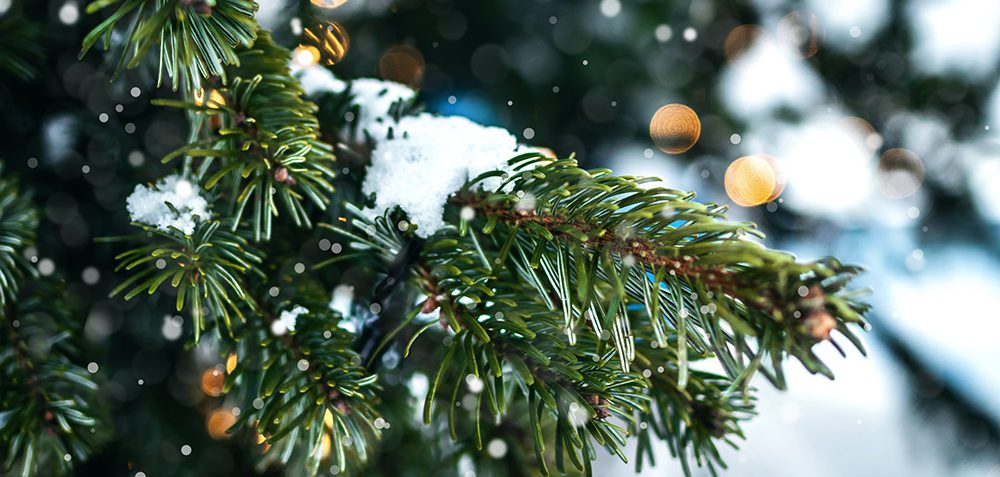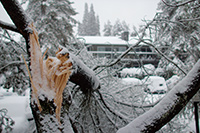 Any tree company in Ocean County knows how hard it is for any tree to survive winter. Last month we discussed how deciduous trees do it. By dropping leaves, non-evergreen trees can go into a state similar to hibernation. Conifers, on the other hand, stay green all year long. Why do some trees need to lose their leaves in order to survive winter and others do not? Let’s take a closer look at conifers, their leaves, and their shape to understand how they make it through months of cold temperatures and reduced resources. It is because of these adaptations that you find many conifers in mountain regions and colder climates.
Any tree company in Ocean County knows how hard it is for any tree to survive winter. Last month we discussed how deciduous trees do it. By dropping leaves, non-evergreen trees can go into a state similar to hibernation. Conifers, on the other hand, stay green all year long. Why do some trees need to lose their leaves in order to survive winter and others do not? Let’s take a closer look at conifers, their leaves, and their shape to understand how they make it through months of cold temperatures and reduced resources. It is because of these adaptations that you find many conifers in mountain regions and colder climates.
Conifers At a Glance

Conifers are commonly referred to as pine trees. While all pine trees are conifers, not all conifers are pine trees. That being said, a majority of the conifer family is made up of pine tree varieties that many people recognize like spruce trees and cypress trees.
A conifer is any type of plant that has a cone. While most people will bring up a picture of a pine cone in their mind when we say that, all cones do not look alike. Some trees have what appear to berries but are actually tightly compacted scales like Juniper trees. Others, like yews, have a cone that looks more like a fruit. What these cones all have in common is that the seeds of these trees are not encased in a fruit, but are bare on the tree.
All conifers are not green and not all conifers are evergreen. There are blue spruces and golden cypress’ and just about every other color you can think of. If you’ve been wanting to add some year-round color to your yard, contact any great tree company in Ocean County (like us) will be able to give you some recommendations. Just as not all evergreens are green, not all ever greens are “ever green.” There are a few species that actually do lose their needles in winter such as the dawn redwood and larch trees.
The shape of conifers is another area where there is some misconception. Just as most people will think of a pinecone when you talk about a cone on a tree, many visualize the classic Christmas tree cone shape when you say evergreen tree. Many, many species of conifers do grow in a tall, conical shape, but not all. There are traditional cones, broad or upright ovals, globes, and mounding varieties.
Hold Onto Your Needles, Winter is Coming
Deciduous trees lose their leaves every winter as a way to conserve energy and protect themselves. Coniferous trees, however, survive the winter by holding onto their needles. The reason needles stay and leaves go has a lot to do with the waxy, outer coating of needles. This covering is called cutin . This not only helps to slow water loss during periods of reduced inputs, but performs photosynthesis with less water. Less water inside and out helps protect the needles, and therefore the tree, from freezing and dying. Plus, these trees have a continuous source of energy throughout the winter in contrast to deciduous trees which do not. The shape and covering of needles also make it difficult for snow to stick to branches which reduces damage during winter storms.
In addition, because conifers don’t drop their needles, when spring comes, they do not need to expend tons and tons of energy growing new ones. There are, of course, some needles that do die and fall off, but they are quickly replaced by new, healthy needles. Needle drop happens at different times and different rates for every species of conifer. Some lose them all at once, like a deciduous, but grow them back before winter. Certain varieties will hold on to needles for 2-5 years, others for 5-7. If you have a conifer in your yard that starts to turn yellow every fall, don’t panic! It could be normal loss of old needles. Not sure if it’s normal for your tree? Give a tree company in Ocean County a call to help figure out if there is a problem.
As a Tree Company in Ocean County, We Love Trees of All Types
No matter what type of trees you have in your yard, deciduous or coniferous, we can help care for them. Oftentimes, new homeowners are not familiar with their trees growing patterns and aren’t sure what is normal and what isn’t. It can take years to get to know your trees, but we can help expedite that. Any time you have a question about the health of one of your trees, give us a call.
Every spring and summer we enjoy lush, full green canopies of trees. We relax in their shade and enjoy their beauty. Yet, every autumn, these gorgeous little appendages begin to die and fall to the ground. But why? Trees that lose their leaves every fall are known as deciduous trees. Most people are familiar enough with the term photosynthesis to know that it is the process in which trees convert air and water into oxygen and sugar to be used for growth and survival. Leaves are a crucial part of this process. If leaves are such a substantial part of the process that trees use to survive, how do they continue to live without them? Learning how deciduous trees survive winter is one topic that as one of the most popular tree companies in Ocean County, we love to discuss.
Tree Companies in Ocean County Know One Reason Trees do Anything is Defense
One of the main reasons that trees do anything is self-defense. Most of these defenses, however, happen without our knowledge. Trees can use chemicals and scents to defend themselves against predators and warn other trees of risks. Deciduous trees dropping their leaves is also a defense mechanism. Winters are rough on everyone and trees are no exception. The severity of the weather puts trees at risk of severe damage and even death. One way that trees defend themselves against these winter harms is with leaf loss. You can help your tree defend itself better by providing regular tre
e maintenance services from professional tree companies in Ocean County like us.
For one, a canopy full of leaves can cause even healthy trees to topple in the severe winter weather. In many areas, wind speeds can increase in the winter. A canopy with leaves can work as a sail using the trees own leaves to uproot itself. However, bare branches allow wind to more freely blow through them. We’ve all watched a tree bend during a winter storm. Imagine how much more severe that effect would be if the canopy was covered in leaves.

Plus, the weight of frozen leaves can be too much for a trunk to take. Ice and snow add a ton of weight onto branches and trunks. Even more weight piles on when the tree doesn’t lose its foliage. A snow laden leafy canopy is a sure way to make a tree top-heavy and greatly increases the likelihood of the tree falling.
Another reason losing leaves protects trees is it helps the tree to conserve resources. During winter in many areas, particularly the northern hemisphere, there is less rainfall. This means less water for trees. It also means leaves are not able to effectively do their job. Without water, photosynthesis cannot happen. Unable to use water to feed the tree, leaves then become a burden. Rather than spending the winter attempting to heal leaves that aren’t able to be saved, it is healthier and better for the tree to drop the leaves and become dormant.
What it Means for a Tree to be Dormant
While it is not the same as hibernation, the state of dormancy that trees go through in the colder months is similar in a number of ways. Hibernation is the state where endothermic animals reduce their metabolic activity in order to survive through times of reduced resources. Just as hibernation, a tree in a state of dormancy has reduced metabolic activity, as well as slowed growth and therefore limited energy usage. Areas of the northern hemisphere can have cold winters that last for months. Losing leaves is the first step of the dormancy process that trees use to adapt to the limited resources during winter. Now that the tree is not using energy for growth or to keep leaves alive, stored energy all goes into keeping the tree alive.

Don’t Be Sad to See Leaves Go Says Tree Companies in Ocean County
Even though the dropping of leaves seems like it is a sign that a tree is dying (and it could be in certain circumstances), when it happens in the autumn, it is simply a sign that a tree is preparing for winter. Another way your trees can better defend themselves in winter is with proper pruning and care. Removing overgrowth and excessive limbs protects the trunk and roots by allowing the tree to grow tall and strong. When it comes to tree companies in Ocean County, we’re a community favorite so contact us today if any trees on your property need professional care.
